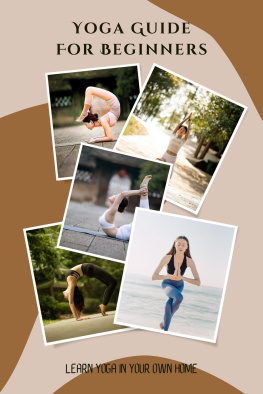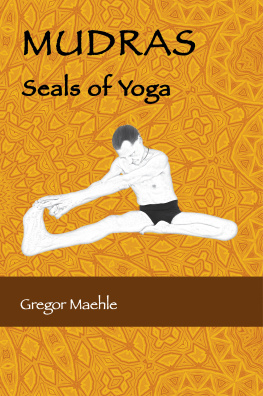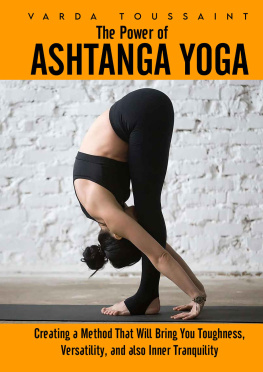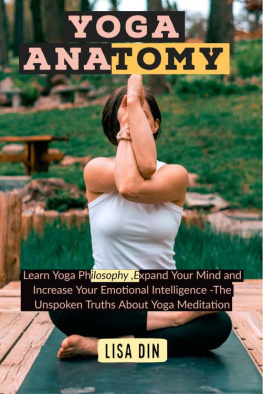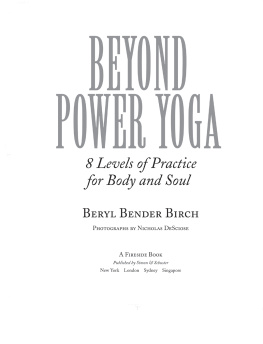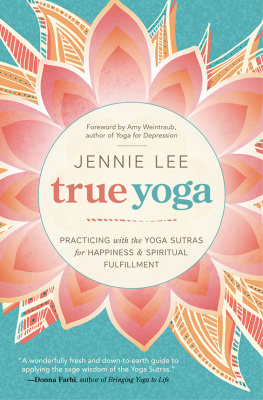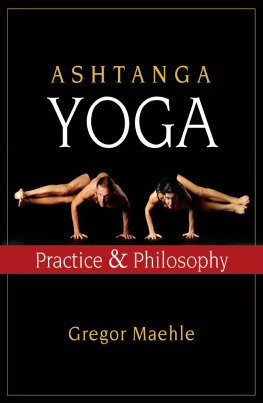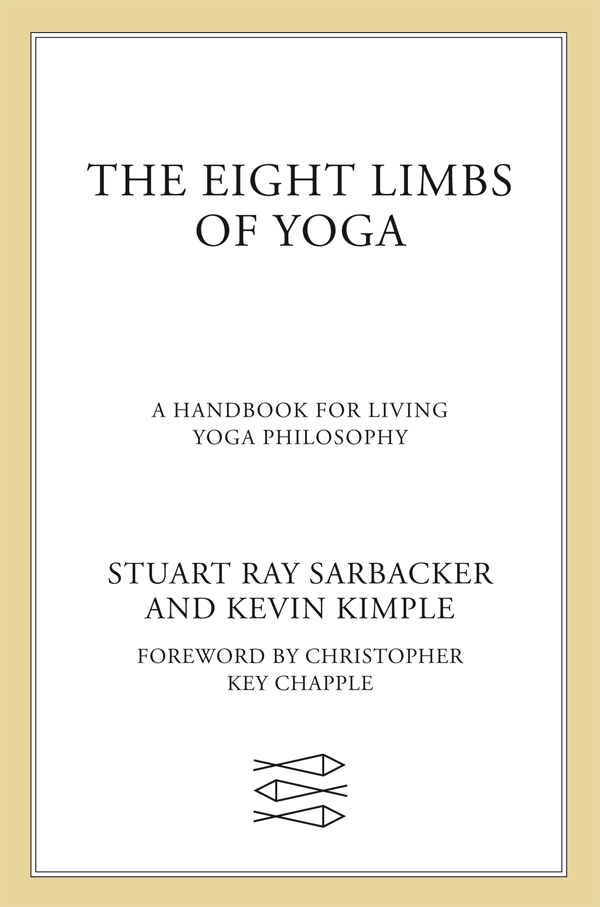Contents
Guide

The author and publisher have provided this e-book to you for your personal use only. You may not make this e-book publicly available in any way. Copyright infringement is against the law. If you believe the copy of this e-book you are reading infringes on the authors copyright, please notify the publisher at: us.macmillanusa.com/piracy.
To all aspiring yogins and yogins
By the strength gained through this practice, we can come to know the method of bringing the mind and sense organs under control. Thus can we achieve yoga. For it is only through the control of the mind and sense organs that we come to know our true nature, and not through intellectual knowledge, or by putting on the garb of a yogi.
Sri K. Pattabhi Jois, Yoga Mala
This concise book provides a users guide to the practice of yoga. Nearly twenty million people regularly practice some form of yoga in the United States. A typical yoga class will include some stretching, some yoga postures, focused breathing, and, generally at the end of the class, a period of deep relaxation. Yoga returns people to their bodies and breath, allowing for a contemplative space to arise.
In some yoga classes, students may be encouraged to pause and cultivate a moment of mindfulness, and perhaps carry that from the yoga class into the world. The beginning point of being mindful, as this book gently shows, entails being aware of the basic need for inner and outer safety. Yoga advocates the principle of do no harm. By restraining oneself from aggression or violence in thought, word, and deed, one develops an atmosphere of peace that can put others at ease. This principle then governs the other ethical teachings of yoga: to be truthful, honest, respectful in matters of sexuality, and nonhoarding. With this ongoing discipline, a person can then seek the positive yoga components of purity, happiness, steadfastness, contemplative study, and dedication to higher ideals.
The mind states of yoga result in the ability to gather oneself inward, to cultivate focus. This focus can lead to meditation, the capacity to sustain attention on a goal higher than and beyond self-concern. Building on the traditional philosophy known as Skhya, yoga provides techniques by which one can rise above mistaken notions governed by ignorance, egoism, attraction, repulsion, and the drive toward self-perpetuation. By understanding the workings of the realm of karma, and by reshaping the body and mind through mastery of breath, one can distinguish between the realm of change and the changeless witness. This witness consciousness, a place of freedom, can become, through yoga, the ground for integrative being in the world.
Samdhi, the goal of yoga, allows one to dissolve the boundaries between self and world. This experience takes many forms and can involve many different techniques. Yoga leaves open many options and can be practiced by atheists as well as by devotees of one of the many embodiments of the divine. By focusing on how the mind functions, yoga shows what is possible, without demanding allegiance to any one particular set of beliefs. Buddhists, Hindus, Jainas, Sikhs, and Muslims have used yogic techniques for centuries, techniques that are now being widely applied in the modern world by Christians, Jews, and secularists.
This book, remarkable for its brevity, provides a road map for the exploration of yoga. Stuart Ray Sarbacker and Kevin Kimple have masterfully covered the basics of yoga philosophy without compromising its complexity and profundity. Read in conjunction with one of the many good translations of Patajalis Yogas tra , this book can help the student of yoga understand the transformative potential of yoga practice.
Christopher Key Chapple
Doshi Professor of Indic and Comparative Theology
Director, Master of Arts in Yoga Studies
Loyola Marymount University
The goal of this short book is to provide a concise and pragmatic guide to the application of the eight-limbed yoga ( a gayoga ) in everyday life. The eight-limbed system is a clear and coherent framework that one can return to again and again to deepen and expand ones understanding and practice of yoga. In the Yogas tra of Patajali, a key text on Hindu yoga philosophy, the eight limbs are used to demonstrate the central principles of yoga, drawing together a spectrum of practices of self-discipline from Hindu, Buddhist, and Jaina sources. The eight limbs of yoga represent various forms of practice ( abhy sa ) that move from the tangible outer world and the body to the subtle inner world of the mind. Progression through the limbs is a movement from external to internal, from social life to psychological life, rooted in the realization that our lives out in the world and our inner lives are connected and coextensive in important ways. The various yoga traditions of India have all recognized the great potential for self-transformation through yoga practice, whether it is thought of in terms of worldly power, liberation from suffering, or some combination of the two. All recognize that to transform oneself through yoga is to transform ones relationship with the world in profound ways.
In the context of Indian philosophical and religious traditions, yoga is understood to transform the body and mind in such a way that ones capacities for action and perception are enhanced. This enhancement is the basis for legendary yoga powers that are discussed in the literature of yoga, such as the Yogas tra , using the language of spiritual accomplishment ( siddhi ). These abilities include reading others minds, heightened powers of vision and hearing, and magical flight, among others. Whether we understand these powers literally or as metaphors, the message is clear: yoga leads to a transformation of the human person such that the limits of human experience are extended and human abilities are perfected. Yet these powers or capacities are often represented in the literature of yoga as impediments or even temptations that may distract a yoga practitioner from the pursuit of liberating knowledge, which is held to be a superior spiritual goal. The idea of pursuing yoga, or any ascetic discipline, for the sake of power is by no means foreign to the Indian philosophical and religious context. In fact, the narratives of Hinduism, Buddhism, and Jainism are filled with examples of individuals who attained great power through yogic and ascetic practice and yet wielded that power in a less than enlightened manner.
In the Yogas tra , such power is acknowledged as real, but the exercise of power out of greed and other afflicted emotions is understood to lead to future misery and the loss of any peace or equanimity that had been found in the practice. The peace or equanimity that one obtains through seeing things clearly is valued above and beyond egocentric aspirations to obtain worldly power and control over others. As we will see later, this is part of the reason why the first limb of yoga is moral restraint ( yama ). Only a person whose practice is rooted in nonviolence, truthfulness, nonstealing, sexual restraint, and nongreed will be able to manage the power, and thus the potential threat, that comes out of the accomplishments to be found in the practice of yoga. In the system of Patajali, yoga is about obtaining freedom from identification with worldly objects and resting in a state of peace that is beyond the flux of psychophysical (mental and physical) life. This peace is an internal freedom from the mental and physical pain of embodied life, and it lays a foundation upon which to build a life that is rooted in peace and of benefit to others.


